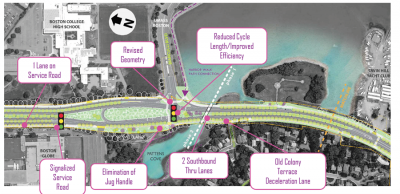July 20, 2017

I commend the Department of Conservation and Recreation for planning modern upgrades for Morrissey Boulevard (MB). However, in my opinion, the 25 percent design plan is not forward thinking, has not sought the input of the city, and perpetuates mistakes of the past.
For 93 years, Dorchester has hosted the roadway, which was designed to expedite travel between communities to our south and downtown. While its construction included the creation of new open spaces and beaches, one of the tradeoffs was the truncation of many local roads and pathways to the sea.
For more than 60 years, Dorchester has also hosted the eight-lane Southeast Expressway/I-93 highway (converted from 6 lanes and breakdown lanes in the 1980s), which has served to further cut off Dorchester from its waterfront while adding more capacity for southern commuters.
The time has come to make Morrissey function as a Dorchester roadway that connects its neighborhoods as opposed to its being a second regional throughway.
This can be accomplished by adding two four-way intersections in the plan’s South Section to reconnect the truncated routes of Conley Street to Freeport Street at the Stop and Shop, and Victory Road to Victory Road with many benefits:
• Signalized crossings for pedestrians and cyclists from the areas west of MB to the Harborwalk, Neponset Greenway, parks, and beaches.
• Increased access between Port Norfolk and other Dorchester neighborhoods.
• Increased utilization of Freeport (parallel to I-93) to access various sections of Dorchester (Ashmont, Pope’s Hill, Clam Point, Fields Corner) for vehicles exiting I-93 at Exit 13.
• Reduced need to rely on u-turns on MB.
• More dispersed traffic overall, taking pressure off existing intersections at Neponset Circle and Freeport Street.
• More signals increase the likelihood that commuters would opt for I-93.
Beyond those measures, imminent and future development must be accommodated in DCR’s planning. Boston’s current hyper-development cycle has the potential to release the massive development of more than 50 acres contiguous to the northern end of MB alone, but no one has even contemplated what could happen on the vast, low-density South Section with its dealerships, strip malls, and parking lots.
With recent and upcoming transactions involving deep-pocketed development firms for large tracts, and the eventual buildout of UMass Boston’s holdings, the current inefficient roadway design demands that the DCR work with the Boston Planning and Development Agency and the city’s Transportation Department to plan for better traffic circulation and access to the hundreds of thousands of square feet of future development.
We saw this coming 10 years ago. For close to two years, I and my volunteer colleagues worked with the-then BRA to create the Columbia Point Master Plan, which called for (and now demands, at the least) one new four-way signalized cross street beginning at the Globe property, heading east across the Santander/BC High property line, across Mt Vernon Street, and through the Bayside property to Day Blvd.
The MB plan needs to accommodate the large intersection that will be built at this new road and I implore DCR to do so. I’m not asking you to build that road; I am asking you not to block its eventuality with your current design that perpetuates the current southbound alignment, which includes the inefficient secondary parallel roadway.
With cooperation and forward thinking, state to private (and vice versa) land swaps, developer funding, and state investment, the solution to Kosciusko Circle could lie in relocating some of the Exit 15 ramps to the area behind the Globe and at the beginning of this new road. There is a rail tunnel beneath I-93 that could be used to access a relocated southbound on ramp, and northbound on-and-off ramps would connect to the new road. This would solve a multitude of problems, not the least of which is completing Frederick Law Olmsted’s vision for the Columbia Road Greenway link to the sea.
Given the projected timetable and phasing of the MB project over 3 sections, I ask that DCR concentrate on completing the design of the Middle Section, and continue to work with the community and the city to refine the other two sections over time, with the goal of making Morrissey Boulevard work as a Dorchester parkway, and to plan for the future access to the impending development of Columbia Point/North Morrissey, and, potentially, the Southern Section’s low density to high density conversion.
Paul Nutting is a Savin Hill resident.

